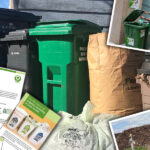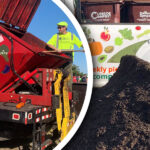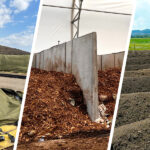
Sally Brown
BioCycle July 2015
I was tremendously relieved when the City of Seattle, Washington extended food scraps collection to multifamily residences. It meant that I could take my food scraps to our marina parking lot and just put them in the green bin — versus schlepping them to our property in the Cascades where I’ve been composting them.
However, most cities and towns in the U.S. don’t have this service. Increasingly, the void is being filled by YIMBY (Yes in my back yard) composting. Community scale composting operations, many nestled in high density residential neighborhoods on vacant lots or at community gardens, are relatively common in New York City, with funding and training coming in part from the City’s Department of Sanitation. Grassroots urban agriculture projects often include composting as part of their operations. Will Allen, head of Growing Power in Milwaukee, Wisconsin, has said that soil is the critical component of growing food. He has also said that all soils in cities are contaminated and so all Growing Power farms are also community composting facilities. According to its website, Growing Power composts 20,000 tons of food scraps annually.
My first reaction to community composting was an irrational “no, not a good idea,” as I envisioned neglected piles, vectors and odors. But a few things have recently forced me to reexamine this issue. I was brought in to consult on the hazards of a proposed centralized composting site that is meeting strong neighborhood opposition by a bunch of NIMBYs (Not in my backyard). And I have started a dialogue with Nance Khelm from Spontaneous Vegetation. Nance, a very vocal YIMBY, has an active composting program in Chicago, which does not have large scale yard trimmings/food scraps collection and composting. Nance became a YIMBY as a result of the vacuum of soil amendments made from municipal organics.
So is there a better model between centralized collection and composting or decentralized neighborhood composting? Several parts in the process need to be considered. A good place to start is with public health. Food waste collection and disposal as a component of trash collection is our norm. This likely came about long ago as a convenience as well as a means to protect public health. A myriad of reasons, including resource conservation, a desire to grow food in urban areas, recognition of the benefits of composts, and an understanding of the climate hazards associated with landfilling, are forcing a reconsideration of this on both a municipal and individual level in the U.S.
Weighing Risks And Benefits
The big public health concerns related to food waste are pathogens and vector attraction. Food scraps could contain pathogens that could make you sick. What looks like garbage to you can look delicious to a range of animals that carry disease, including rats and other rodents. Composting, if properly done, is an excellent way to destroy pathogens and, by creating a stable soil amendment, simultaneously reduce vector attraction potential. Regulations help assure that centralized composting is done to eliminate pathogens with time and temperature requirements. On a neighborhood level, we have no such assurances, so the potential that complete pathogen kill via thermophillic composting is not being achieved is higher. Time is the factor that achieves pathogen kill for home composters and may be the case for community-scale operations as well. It is also true that even if pathogen kill isn’t achieved, it is highly likely that considerable reduction in pathogens is seen. With food scraps, this is likely not a public health issue. So for this, I give a slight advantage to centralized systems.
Next are health and nuisance impacts related to the composting process itself. According to the NIMBYs, the primary worries are bioaerosols and odors. A review of the literature does indicate that bioaerosols, airborne particles that contain or are derived from living organisms, can be a concern. But this is only for the people in close proximity to the piles, i.e., workers at composting facilities — not neighbors of composting facilities. Common bioaerosols from composting can include microbes such as fungi, actinomycetes, gram negative bacteria and endotoxins, and when inhaled in significant quantities, could make someone ill. The exact quantities of bioaerosols required to make someone sick has not been clearly defined but depends on how healthy you are to begin with. High concentrations are most commonly seen in receiving areas and during screening and turning of piles. Risks are greater for indoor sites with limited airflow and can be minimized through use of biofilters. Exposure to bioaerosols is much more likely to be a hazard at large-scale facilities where full-time employees are exposed on a daily basis. For community systems located outdoors and usually with only part-time staff, hazards are likely to be much less. Here the vote goes to decentralized or neighborhood systems.
Odor is the next consideration. As someone pointed out at the BioCycle West Coast Conference 2015 in Portland in April, it is not a question of whether or not composting smells. It is a question of whether those smells are offensive. The best ways to generate smells from composting that fall into the offensive odor category are to have anaerobic conditions in the pile or to be in close proximity to neighbors who don’t want you there in the first place.
Larger scale operations will more likely have the resources available to implement and enforce use of odor mitigation tools such as higher rates of aeration and engineered biofilters. They have little choice given the large quantity of materials processed and the potential for NIMBYs to shut them down. Community scale operations have to be equally vigilant, but may be less likely to effectively control odors, and the ones that are caused may be forgiven due to community support. In fact, YIMBY is, practically speaking, a highly effective odor mitigation strategy. Nonetheless, the YIMBY can turn quickly into a NIMBY if prolonged odors start impacting quality of life in a neighborhood. I’ll give this one a draw.
Finally there is a question of final product quality. Getting people serviced by food scraps collection programs to pay enough attention to actually put their scraps in the organics bin is one hurdle. Getting them to make sure that only the food scraps go into the bin is an even larger hurdle. For small-scale neighborhood operations, there is a much greater potential for full buy in. Bringing your scraps to your neighborhood facility where they know you also means that they can yell at you if you bring scraps and contaminants. There is also potentially less monitoring of final C:N ratios and particle sizes but with food waste as a feedstock, there is a low potential for nutrient-poor products. Here the vote goes to the YIMBYs.
Tally up the score and we are pretty close to a draw. A major advantage of large-scale systems is they produce enough compost to supply large-scale uses such as highway right of ways, housing developments, and storm water bioretention systems. Neighborhood systems are great in a vacuum. They are also great to bring communities together, teach people about soils and turn neighborhoods green. Maybe it doesn’t have to be a choice between NIMBY and YIMBY. Maybe the best of both worlds means both options.
Sally Brown is a Research Associate Professor at the University of Washington in Seattle and a member of BioCycle’s Editorial Board.












